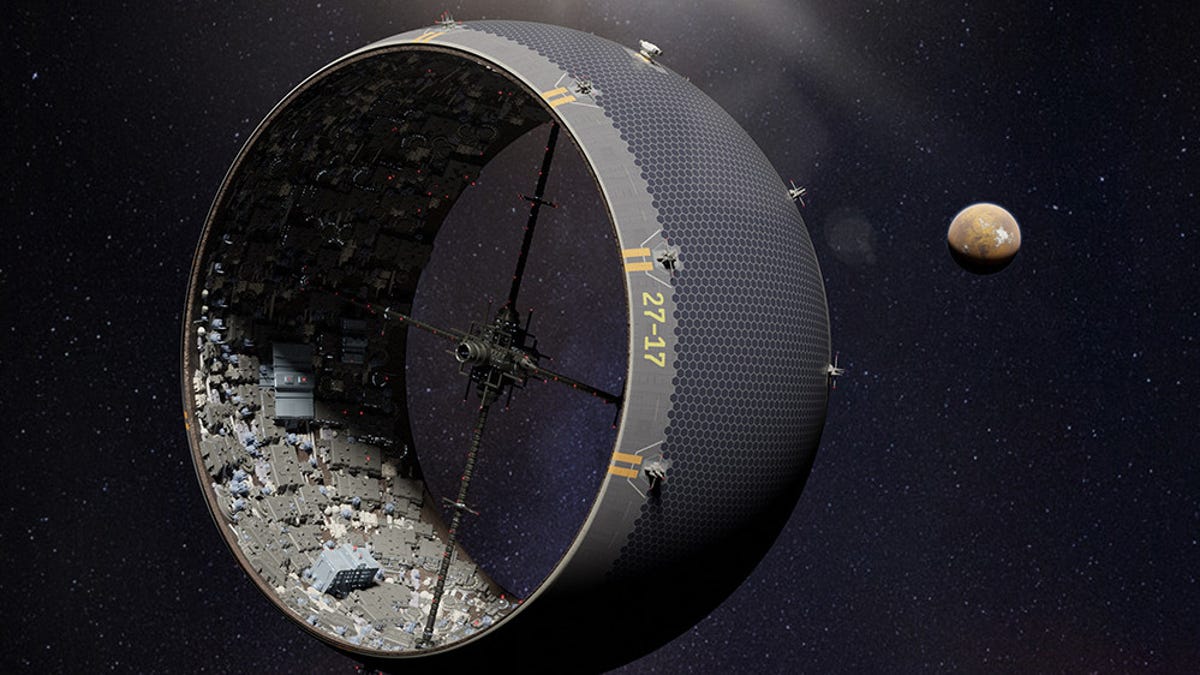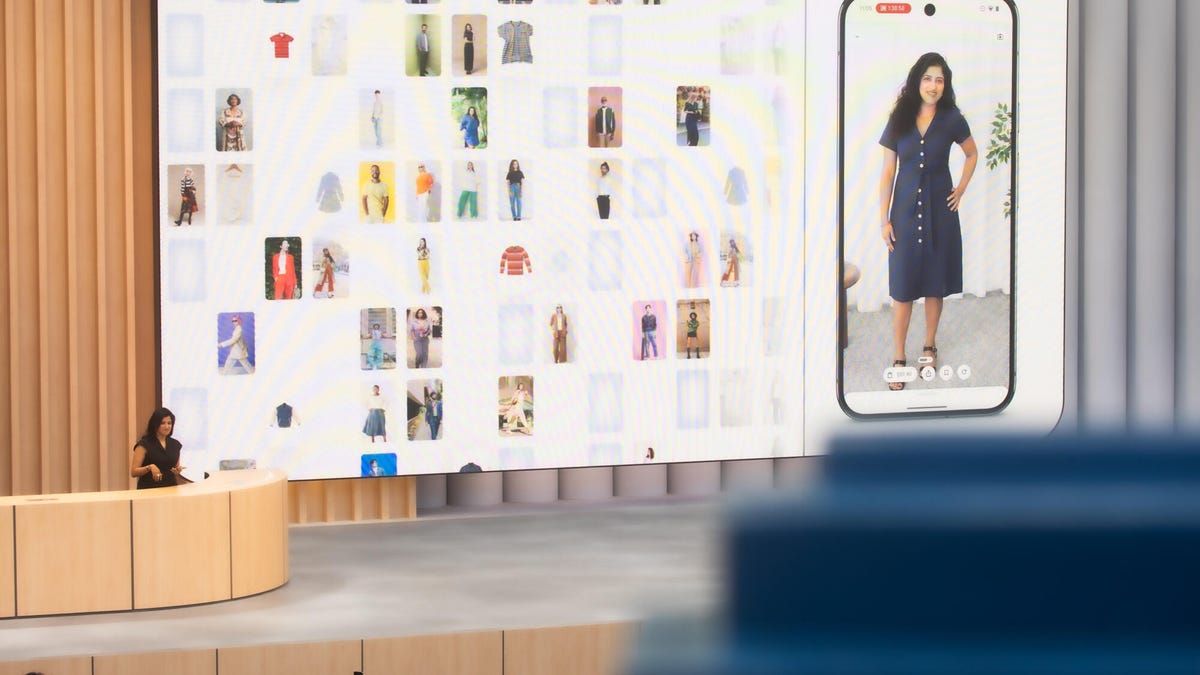Technologies
Space Cities Inside Asteroids Could Actually Work, Scientists Say
The plan «on the edge of science and science fiction» involves an asteroid, an expandable mesh bag and a whole lot of audacity.

Good news, Earthlings. We have more to look forward to than just the drab landscape of the moon or the inhospitable surface of Mars when it comes to far-flung future human civilizations off this rock. We might one day be living la vida asteroid.
Yes, space-faring piles of rocky rubble (like famous asteroid Bennu) could be home sweet home. A group of scientists at the University of Rochester in New York worked out a plan for turning asteroids into spinning space cities with artificial gravity. The researchers published a «wildly theoretical» study in Frontiers in Astronomy and Space Sciences earlier this year.
«Our paper lives on the edge of science and science fiction,» said co-author Adam Frank in a University of Rochester statement last week. Frank is a professor of physics and astronomy at the school.
The basic concept behind the asteroid city builds on an idea called the O’Neill cylinder, a rotating space colony design proposed by physicist Gerard O’Neill in the 1970s. The rotation creates artificial gravity. Think of something along the lines of the cylindrical Cooper Station in the movie Interstellar. It’s a fascinating idea, but it would be difficult and expensive to transport enough material into space to make a large-scale O’Neill cylinder.
This is where things get wilder. The Rochester research team proposes a way to turn a rock pile of an asteroid into a cylinder by surrounding it with a thin, high-strength mesh bag made from carbon nanofibers. It would have an accordion-like design.
«A cylindrical containment bag constructed from carbon nanotubes would be extremely light relative to the mass of the asteroid rubble and the habitat, yet strong enough to hold everything together,» said study co-author Peter Miklavcic, a doctoral candidate in mechanical engineering.
Spinning an asteroid would cause its rubble to break apart, expanding the bag and creating a layer of rock against it. That layer would provide radiation shielding for a colony inside the cylinder while the continued spin would create artificial gravity.
It sounds far-fetched, but Frank said the technologies and engineering behind the asteroid city technically obey the laws of physics. «Based on our calculations, a 300-meter-diameter asteroid just a few football fields across could be expanded into a cylindrical space habitat with about 22 square miles of living area,» Frank said. «That’s roughly the size of Manhattan.»
Of course, bagging and spinning an asteroid wouldn’t be simple. The researchers suggest using solar-powered rubble cannons to get the spin going. There’s also the matter of constructing a human-safe colony on the interior, but we can leave those challenges for the future.
Sci-fi writers have long envisioned life on asteroids. The paper provides a new way of thinking through that possibility in a way that could protect human occupants and make them feel more at home. It’s a good companion piece to another recent space thought experiment that offered up a plan for building a «forest bubble» on Mars.
My imagination is now taking me from my cozy quarters inside an asteroid to a vacation destination in a Martian nature reserve. This may not be relegated to the realm of sci-fi forever. «Space cities might seem like a fantasy now,» Frank said, «but history shows that a century or so of technological progress can make impossible things possible.»
Technologies
iOS Gets More AI as Chrome Adds Google’s Gemini for iPhones
iPad users also won’t need to go elsewhere for their AI needs.

Google is adding its artificial intelligence tool Gemini to the Chrome browser on iPhones and iPads across the US, meaning you’ll be able to use Google’s AI functionality in Chrome instead of having to go to the Google app on your devices.
The integration comes a few months after Google rolled out Gemini in Chrome to Windows and Mac desktop users in the US in September. At the time, the company said that it would eventually be doing the same thing with iPhones and iPads.
Don’t miss any of our unbiased tech content and lab-based reviews. Add CNET as a preferred Google source.
Before now, if you wanted to use Gemini on your iPhone and iPad, you were not able to do so from Chrome — you would have had to go to the Google app or Google website.
Folks using Android phones already have Gemini on their Chrome browsers, which is the default browser on Android devices.
Chrome is the most widely used web browser in the US; StatCounter said that as of November, Chrome had a 54% market share of browsers in the US, followed by Apple’s Safari (28%) and Microsoft Edge (7%). There are other smaller browsers that people use to search the internet, including Firefox, Brave, Opera, Vivaldi and Arc.
Gemini is Google’s family of AI products and competes with ChatGPT, Microsoft Copilot, Anthropic’s Claude, Perplexity AI, Mistral AI, Meta AI and Grok in the realm of chatbots, content creation and AI integration.
‘Gap’ has been filled
Jason Howell, host of the Android Faithful Podcast and a former CNET staffer, said Google has filled «a noticeable gap» in AI for Chrome for the millions of iPhone and iPad users in the US.
«Giving Gemini awareness of what’s happening inside the Chrome browser has real utility, and placing that spark icon front and center will nudge a lot of people to try it who might not have otherwise,» Howell said. «It’s a smart distribution play. Put your AI in an app that millions already have installed, and you’re giving them an enticing reason to test it.»
Howell said adding Gemini into Chrome for iOS could give Google the edge on, well, Edge.
«Microsoft already brings Copilot to iOS through its dedicated apps and even inside the Edge browser, so this isn’t Google pulling ahead so much as it is Google catching up in an important and highly visible place,» Howell said. «Having said that, Chrome has a much larger footprint on iOS compared to Edge, so it’s using its scale to put Gemini in front of far more iPhone and iPad users, which could meaningfully shift adoption among third-party AI assistants.»
What can you do with Gemini?
Gemini in Chrome is not immediately available to everyone using iOS devices, but it is gradually rolling out across the US. To be able to get it, you need to be running Chrome version 143, sign into your account and make sure the browser language is set to English; you also cannot be in Incognito mode.
Chrome users in iOS will know they have Gemini when the Google Lens icon (which looks like a camera with a dot in the middle) to the left of the address bar is replaced by the Gemini icon (which looks like a sparkle).
When you tap or press the Gemini icon, two options will appear on a «Page tools» screen that slides up: Search screen and Ask Gemini. Two shortcuts that will appear are Summarize page and Create FAQ about this topic.
Let’s say your web page is about the top news events of 2025. You could ask Gemini, «Give me a list of the top events for each month,» or, «List out the top political news of 2025.» Maybe you’re looking at a great meal to prepare but you need substitutes for certain ingredients — you could ask Gemini to provide suggestions. Just remember to double-check everything an AI tool tells you because AIs have been known to hallucinate.
Gemini for Chrome in iOS will also make checkout easier with biometrics instead of a CVC code during online shopping.
Technologies
Strike a Pose: Here’s How to Use Google’s Upgraded Virtual Try-On Feature
The refined Google shopping feature now works without a full-body photo. Instead, it generates one virtually.

Say goodbye to awkward dressing-room selfies. Google is upgrading its existing AI-powered try-on tool, which allows you to skip an in-person shopping trip and view yourself in clothes virtually with the help of AI.
The update, announced on Thursday, adds the option to generate a complete digital version of yourself, rather than providing a full-body photo. So, if you have a great selfie but happen to be sitting down in the image or it’s a head-and-shoulders-only photo, you can now use it. The tool will ask what size body you want it to create, from XS to 4XL+, and create a full-body avatar with your image. So, even if you don’t have a need to wear a full-length, formal satin gown or black leather pants, you can see how you might look if you did.
You must be in the US, so if you are, upload a selfie to the website and select a size, and Nano Banana — Google’s Gemini 2.5 Flash Image model — will generate a full-length image, allowing you to click around and try out outfits.
Don’t miss any of our unbiased tech content and lab-based reviews. Add CNET as a preferred Google source.
Google initially introduced its AI try-on feature in May at its I/O developers conference. You’ll still be able to virtually try on clothes using a full-body photo if you prefer.
Technologies
Today’s Wordle Hints, Answer and Help for Dec. 12, #1637
Here are hints and the answer for today’s Wordle for Dec. 12, No. 1,637.

Looking for the most recent Wordle answer? Click here for today’s Wordle hints, as well as our daily answers and hints for The New York Times Mini Crossword, Connections, Connections: Sports Edition and Strands puzzles.
Today’s Wordle puzzle came fairly easy to me. It’s a common word, and the letters are ones I guess right away. If you need a new starter word, check out our list of which letters show up the most in English words. If you need hints and the answer, read on.
Today’s Wordle hints
Before we show you today’s Wordle answer, we’ll give you some hints. If you don’t want a spoiler, look away now.
Wordle hint No. 1: Repeats
Today’s Wordle answer has no repeated letters.
Wordle hint No. 2: Vowels
Today’s Wordle answer has one vowel.
Wordle hint No. 3: First letter
Today’s Wordle answer begins with T.
Wordle hint No. 4: Last letter
Today’s Wordle answer ends with K.
Wordle hint No. 5: Meaning
Today’s Wordle answer can refer to a large motor vehicle used for hauling things or people.
TODAY’S WORDLE ANSWER
Today’s Wordle answer is TRUCK.
Yesterday’s Wordle answer
Yesterday’s Wordle answer, Dec. 11, No. 1636 was GUESS.
Recent Wordle answers
Dec. 7, No. 1632: FLUTE
Dec. 8, No. 1633: GRAVY
Dec. 9, No. 1634: SNIDE
Dec. 10, No. 1635: ERASE
Don’t miss any of our unbiased tech content and lab-based reviews. Add CNET as a preferred Google source.
-

 Technologies3 года ago
Technologies3 года agoTech Companies Need to Be Held Accountable for Security, Experts Say
-

 Technologies3 года ago
Technologies3 года agoBest Handheld Game Console in 2023
-

 Technologies3 года ago
Technologies3 года agoTighten Up Your VR Game With the Best Head Straps for Quest 2
-

 Technologies4 года ago
Technologies4 года agoBlack Friday 2021: The best deals on TVs, headphones, kitchenware, and more
-

 Technologies4 года ago
Technologies4 года agoVerum, Wickr and Threema: next generation secured messengers
-

 Technologies4 года ago
Technologies4 года agoGoogle to require vaccinations as Silicon Valley rethinks return-to-office policies
-

 Technologies4 года ago
Technologies4 года agoOlivia Harlan Dekker for Verum Messenger
-

 Technologies4 года ago
Technologies4 года agoiPhone 13 event: How to watch Apple’s big announcement tomorrow
